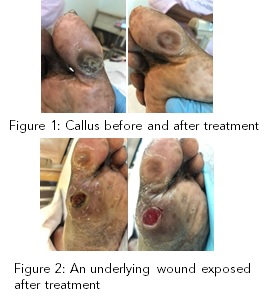What are Calluses and Corns?
Calluses and corns are thickened hardened skin caused by prolonged excessive pressure or shear on your skin.
- Calluses usually present as larger areas of thickened skin and are quite flat.
- Corns, commonly known as ‘chicken eyes’, are usually smaller and penetrate into the deeper layers of the skin resembling pebbles.
Both calluses and corns can cause pain and underlying wounds if neglected.
Why Do You Need to get Your Calluses and Corns Treated?
- You may experience pain if they are left untreated for too long
- The deeper layers of skin may also be damaged and this increases the potential for wounds to develop beneath the surface of the callus or corn
- Timely treatment will reduce both pain and reduces the chances of developing wounds
- This is important for patients with high risk foot, e.g. patients’ who have diabetes commonly have poorer sensation and/or blood supply
Example: Patient ‘A’ has diabetes, foot deformities on both feet and has lost the protective sensation in both her feet. Due to the loss of sensation, she does not feel pain and is unaware of how thick her calluses have grown. She is usually seen by Podiatry once every two months for callus removal.

Scenario One: Patient ‘A’ returns to Podiatry after two months, and has her calluses debrided. There are no underlying wounds and the foot is kept safe for a further two months.
Scenario Two: Patient ‘A’ missed her two-month scheduled Podiatry appointment, and only sees her podiatrist six months later. During the treatment, the Podiatrist observes the callus has already split apart and a wound has formed underneath. The true size and extent of the underlying wound can be seen in Figure 2.
Signs Indicating That a Wound has Developed Underneath Calluses/Corns Include:
- Discolouring of the skin, in or around the callus
- Bleeding, pus or discharge coming from the callus
- A split, tear or opening in the callus
What Should You do if You Notice a Wound?
- Immediately cleanse the wound thoroughly with saline and apply a dry dressing
- Keep the dressing dry at all times
- Seek medical help as soon as possible
What are the Risks and Complications of Having Your Callus/Corn Removed?
You will be assessed prior to and after the treatment of the calluses or corns. Potential risks and complications may include:
- Bleeding at the area
- Sensitivity of the skin following treatment
- Subsequent risk of infection if a wound is discovered and proper home wound care is not followed
What Should You do Before Treatment?
- No preparation is required before the procedure
- Keep your feet clean, to allow the Podiatrist ease in inspecting your feet
- DO NOT use salicylic acid based products, like corn preparations or corn plasters, to self-remedy as these can damage the skin and cause it to breakdown and form into wounds.
What Should You do After Treatment?
- Wear supportive, well-fitted shoe wear every day to reduce excessive pressure on the feet. Your Podiatrist will advise you on the features to look for to ensure the shoe is suitable. This will be the most effective way in reducing re-growth of calluses or corns.
- Apply moisturising lotion to your feet daily, to both the top and bottom surfaces of your feet
- DO NOT attempt to cut or tear the hard skin, as this may cause bleeding and increase risk of infection
- Return for your Podiatry review appointment as advised by your Podiatrist
Will the Callus/Corn Grow Back Again?
- If the excessive pressure is not well-managed, the callus or corn will grow back again.
- However, if the pressure on the skin is reduced by following the treatment protocol, such as wearing supportive footwear, the callus or corn will grow back slower, less thick and less painful than before.
What is the Expected Interval of Treatment Required?
This depends on the extent of callus growth. For example, heavy callus regrowth in rheumatoid arthritic patients is expected, due to their significantly deformed feet. As such, they will usually require shorter review appointment intervals, to reduce the chances of wounds developing.
What are the Warning Signs That You Need to Watch out for?
If you notice any one of the following warning signs:
- Extreme localised pain
- Fever or chills
- Swelling and extreme redness develop
- Strong odour or smell
- Localised discharge
- A change in colour around the surrounding skin
- A new wound developing
Please seek immediate medical attention with any general practitioner or TTSH Emergency Department.
